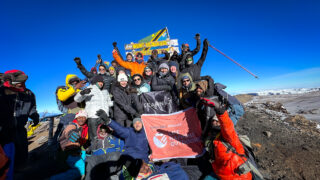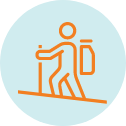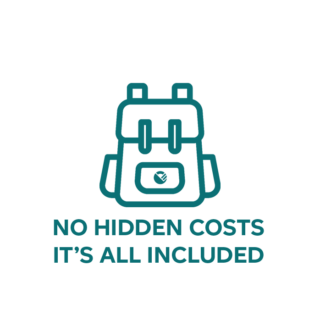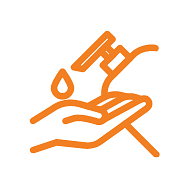
Challenging Tanzania
Our Kilimanjaro expedition is meticulously designed for safety, unforgettable experiences, and personal transformation. Drawing from over a hundred successful climbs, we've curated every aspect of this climb, including a nutritious food menu to enhance acclimatization, regular health checks to keep track of your progress and clean private camping facilities including our own toilets to maintain personal hygiene. Our expert LHO Team Leaders collaborate closely with our local guides and porters to prioritize your safety and ensure you return with the cherished memories of a life-changing journey.

TRIP TYPE
Trekking, Summit

DURATION
9 Days

DESTINATION
Tanzania
1
Led by our expert LHO Team Leaders with years of high-altitude experience.
2
Meals are carefully curated and deliciously prepared by our LHO-trained Chef.
3
100% safety record on all our Kilimanjaro expeditions.






WHAT'S INCLUDED IN THIS TRIP
WHAT'S NOT INCLUDED IN THIS TRIP
WHAT'S INCLUDED IN THIS TRIP
WHAT'S NOT INCLUDED IN THIS TRIP
DAY 1: JAMBO KILIMANJARO!
Upon arrival at Kilimanjaro International Airport, you will be met by a member of the LHO team and transferred via private shuttle to the hotel, where your LHO Team Leader will be waiting to greet you. Once you have settled in, we will conduct a gear check to ensure you have everything you need for the climb.
If you arrive early, you can explore the lively town of Moshi at the base of Kilimanjaro. Coffee lovers should try Union Coffee Shop. Your Team Leader will share more recommendations closer to your trip.
In the evening, we will gather for a team dinner and briefing, either at a local restaurant or our hotel depending on group needs. This is your first chance to meet fellow climbers and your lead guides, ask questions, and learn more about the adventure ahead. We will make sure you are well prepared and rested for the days to come.
DAY 2: THROUGH THE TOWERING RAINFOREST
Distance: 10 KM | Ascent: 1220 M | Descent: 22 M | Max Altitude: 2,835 M
Our first day on the trail begins after breakfast and hotel checkout. We will take a private shuttle to the Machame gate, about an hour away, and complete park check in. This process can take around one hour, during which a hot lunch will be served at the gate.
The trail starts in the lush rainforest, with chances to spot wildlife like monkeys. This section features beautiful flora and a mix of steep and gentle inclines. Our LHO team will guide you to a comfortable and sustainable pace to ease into the rhythm of Kilimanjaro. We expect to reach Machame Camp at 3000 meters near sunset, where dinner awaits.
For many, this may be the first night ever camping. We will provide a short induction on campsite etiquette, how to use our private bathrooms, where to find tea, coffee, or hot water, and tips for maximizing comfort inside your tent.
DAY 3: THE MOUNTAIN OPENS UP
Distance: 5 KM | Ascent: 865 M | Descent: 50 M | Max Altitude: 3,840 M
On our second day, we start early, leaving the rainforest behind and entering the short grass zone. The first morning can feel a bit overwhelming with packing, breakfast, and health checks, but your LHO Team Leader will be there to guide you through it.
As we begin hiking, the jungle slowly gives way to alpine terrain. Vegetation shrinks, and wide open views emerge. The trail becomes rockier, replacing the rainforest mud. By midday, we reach Shira Camp at 3,700 meters, named after the now collapsed Shira crater. A hot lunch is served on arrival.
The afternoon is yours to relax, adjust to the altitude, and take in sweeping views of Mount Meru on the horizon. The contrast in landscape from the previous day is striking and energizing. Dinner is served at camp as we prepare for our continued ascent toward the summit of Kilimanjaro.
DAY 4: A TOWER OF LAVA
Distance: 10 KM | Ascent: 820 M | Descent: 680 M | Max Altitude: 4,600 M
This is one of the longest and most important trekking days, designed to help us acclimatize properly. We start earlier than usual to get ahead of the afternoon rains that often reach Lava Tower by midday due to Kilimanjaro’s microclimate.
We ascend to nearly 4,600 meters at Lava Tower before descending to Barranco Camp at 3,900 meters. This high route helps our bodies adjust to the altitude. A hot lunch will be served in our common tent at Lava Tower, followed by a scenic descent to Barranco, where a hot dinner awaits.
The terrain transforms dramatically as we cross the alpine desert, surrounded by striking rock formations from past eruptions. Snow is sometimes seen on this part of the trail. As we descend, we pass through a forest of Dendrosenecio Kilimanjaro trees, a rare species found only on this mountain. This day is a key milestone in preparing both body and mind for the summit ahead.
DAY 5: THE BARRANCO WALL
Distance: 4.2 KM | Ascent: 400 M | Descent: 350 M | Max Altitude: 4,200 M
The Barranco Wall rises 300 meters above our camp. From a distance, it may appear daunting, but as we approach, the route reveals itself. A short walk from camp brings us to the base, and the ascent begins. It is one of the most exciting days of the trek, filled with great photo opportunities and a sense of adventure.
After reaching the top, the trail levels out, and we continue along well marked terrain. Our goal is to reach Karanga Camp in time for a hot lunch.
The rest of the day is dedicated to rest and acclimatization. Relaxing at Karanga is essential, as this is our final opportunity to recover fully before our summit attempt. Your LHO team will be on hand to monitor how you are adjusting to the altitude and to help you prepare mentally and physically for the challenging days ahead.
DAY 6: BASE CAMP TO THE SUMMIT
Distance: 3.7 KM | Ascent: 640 M | Descent: 25 M | Max Altitude: 4,550 M
This is the shortest day on the mountain. The walk to Barafu Camp at 4600 meters is both scenic and brief, with the summit ridge of Kilimanjaro visible above us throughout the hike. Before setting out, we conduct a routine health check. This one is especially important, as it determines whether you are cleared to proceed into higher altitude.
We approach the day with a focused mindset, mirroring our summit night strategy with short breaks and a slow, steady pace. Upon arrival at Barafu, we have lunch and receive a full summit briefing.
The afternoon is reserved for rest and preparation. Dinner is served earlier than usual to allow for adequate sleep before the summit attempt. Around midnight, we wake up to begin our final push toward the roof of Africa.
DAY 7: THE ROOF OF AFRICA
Distance: 16 KM | Ascent: 1250 M | Descent: 2800 M | Max Altitude: 5,895 M
We typically start walking between midnight and 1 am, depending on the group’s pace. Before we set out, you can grab snacks, biscuits, and hot tea. The steepest section comes first as we exit Barafu Camp, climbing over rocky terrain similar to our approach to Shira Camp. After 30 minutes, the trail levels out near Kosovo before rising again via long switchbacks toward Stella Point. This is where the altitude gain is most intense.
From Stella Point, it is a 40 minute walk to Uhuru Peak, with glaciers beside us and the crater ridge below. On clear days, you can see the Savanna stretching into Tanzania and Kenya. Your LHO Team Leader will capture the moment as you take the final steps to the summit.
After photos and a short celebration, we descend to Barafu for lunch and rest, then continue to Mweika Camp at the edge of the rainforest, where deep sleep awaits.
DAY 8: SHOWERS & FAREWELLS
Distance: 8.6 KM | Ascent: 0 M | Descent: 1444 M | Max Altitude: 2,800 M
The final morning is always bittersweet. While we look forward to a hot shower and reflection, it is hard to say goodbye to the people who made this journey possible.
Before setting off on our last three hour descent, the LHO team hosts a farewell celebration at camp. Our porters, guides, chefs, and staff come together for one final send off. This is also the time to offer tips, and your Team Leader will privately guide you through the process.
After a full team photo, we begin the descent from Mweika Camp through the lush rainforest to the national park gate. Lunch will be served at the gate as our staff complete the final check out procedures.
We then return to the hotel for well deserved showers and rest. That evening, our adventure concludes with a celebratory team dinner hosted by your LHO Team Leader and any remaining LHO guides.
DAY 9: HAKUNA MATATA RAFIKI!
The final day is dedicated to airport transfers. Breakfast is included at our hotel. Team members will be shuttled to the airport depending on flight times. Please be sure to communicate the correct flight times when you fill out your Team Details Form prior to this experience. Please make sure to communicate any changes to your LHO Team Leader as early as possible to ensure that arrangements are made.
DAY 1: JAMBO KILIMANJARO!
Upon arrival at Kilimanjaro International Airport, a member of the LHO team will greet you and transfer you to the hotel in our private shuttle. Your LHO Team Leader will be waiting at the hotel to meet you. After settling in, we’ll conduct a gear check to ensure you’re fully prepared for the climb.
If you arrive early, feel free to explore the lively town of Moshi at the base of Kilimanjaro. Coffee and pie lovers can check out the Union Coffee Shop, with more recommendations to come from your Team Leader closer to your trip.
In the evening, we’ll gather for a team briefing and dinner at a local restaurant or hotel, depending on what suits the group. This is your first chance to meet fellow participants, your lead local guides, and ask any questions about the journey ahead.
DAY 2: THROUGH THE TOWERING RAINFOREST
Distance: 7.5 KM | Ascent: 817 M | Descent: 11 M | Max Altitude: 2,734 M
Our first day on the trail begins after breakfast and hotel checkout. We’ll take a private shuttle to the Marangu gate, about an hour’s drive away, where we’ll complete the check-in process. This can take around one hour, and during this time, we’ll serve a hot lunch at the gate.
The first part of the trail leads us through the lush rainforest, with opportunities to spot wildlife like monkeys. The terrain fluctuates between steeper inclines and gentler ascents. Your LHO team will help you find a comfortable pace and get into the rhythm of the climb. We aim to reach Mandara Hut (2,734 meters) around sunset, where a delicious dinner will be served.
For many, this may be their first time staying in mountain lodges. Don’t worry! We’ll provide a brief induction on lodge etiquette, bathroom locations, and where to find tea, coffee, and hot water for washing.
DAY 3: THE MOUNTAIN OPENS UP
Distance: 11.7 KM | Ascent: 1041 M | Descent: 39 M | Max Altitude: 3,700 M
On Day 2, we start early, aiming to leave the rainforest and enter the short grass zone. The morning can feel overwhelming as we pack up, have breakfast, perform health checks, and head out for the first time. But don’t worry—you’ll adjust quickly, and your LHO Team Leader will be there to guide you.
As we hike, the landscape transitions from jungle to alpine as we ascend to 3,700 meters. The vegetation shrinks, and the views open up, revealing the summit crater and Mawenzi Peak. The trail changes from muddy to drier soil, with open vistas replacing the dense rainforest.
We’ll stop for a hot lunch at the halfway point in a designated picnic area with tables, benches, and fixed toilets. After lunch, we’ll continue our gradual ascent to Horombo Hut (3,700 meters), arriving in the mid-afternoon. The evening offers stunning sunset views before dinner.
DAY 4: ZEBRA ROCK
Distance: 12.3 KM | Ascent: 895 M | Descent: 895 M | Max Altitude: 4,350 M
Day 3 is an acclimatization day, crucial for helping our bodies adjust to higher altitudes. After a late breakfast, we’ll begin our hike toward Mawenzi, Kilimanjaro’s second-highest peak. Along the way, we’ll pass Zebra Rock, a striking formation with black and white stripes.
While most expeditions stop at Zebra Rock, we’ve found that this mild altitude gain doesn’t offer sufficient acclimatization. Instead, we choose to hike all the way to Mawenzi Hut (4,350 meters), the base camp for Mawenzi Peak. This route offers stunning views of Kilimanjaro’s second-highest peak and better supports our acclimatization process.
Lunch will be served at Mawenzi Hut, after which we’ll descend back to Horombo Hut for an afternoon of rest and recovery. This approach ensures our bodies have the time they need to adjust to the altitude and better prepares us for the summit.
DAY 5: THROUGH THE SADDLE
Distance: 7.9 KM | Ascent: 460 M | Descent: 282 KM | Max Altitude: 4,700 M
After breakfast, we begin our hike through Kilimanjaro’s moorland and alpine desert. We’ll pass the Maua River, a small mountain stream that seems out of place in this dry section of the mountain. The river is surrounded by Dendrosenecio Kilimanjaro trees, which are unique to Kilimanjaro.
As we continue, the terrain flattens, and the vegetation begins to fade. Ahead, we’ll see the Kibo crater, the highest crater on Kilimanjaro, where Uhuru Peak stands. With each passing hour, the towering cone of Kibo draws closer. We’ll be flanked by two smaller peaks on either side as we cross the saddle, the section of trail between the peaks.
We’ll stop for a hot lunch at a designated picnic area on the saddle before heading east toward Kibo Hut (4,700 meters), the base camp for our summit attempt. This is our final stop before the ascent to Uhuru Peak.
DAY 6: REST AND ACCLIMATIZATION
Distance: 3.2 KM | Ascent: 450 M | Descent: 450 M | Max Altitude: 5,000 M
Most expeditions push for the summit the night they arrive at Kibo Hut, but we’ve found that this doesn’t allow enough time for proper acclimatization, which could be unsafe. To address this, we’ve built an extra day into our itinerary for recovery, rest, and acclimatization.
This isn’t just a rest day. We’ll take a short trek up to William’s Point at 5,000 meters, which gives us an extra opportunity to acclimatize before returning to Kibo Hut for lunch. The afternoon will be dedicated to rest and relaxation.
At lunchtime, we’ll hold a summit briefing to discuss the details of the upcoming climb and answer any questions. We’ll also enjoy an early dinner to ensure we’re well-rested before the wake-up call at midnight to begin our summit ascent.
DAY 7: THE ROOF OF AFRICA
Distance: 19.2 KM | Ascent: 1196 M | Descent: 2200 M | Max Altitude: 5,895 M
We typically begin walking between midnight and 1 am, depending on the group’s pace. Before starting, we’ll have snacks, biscuits, and hot tea to fuel up.
The trail begins with moderate inclines toward William’s Point. As we get closer to the crater rim, the trail becomes rockier with larger boulders. The toughest section is the final 100 meters to Gilman’s Point, requiring focus as we navigate over rocks. Reaching Gilman’s is a relief, as the trail flattens and the summit comes into view. The halfway point between Gilman’s and the summit is Stella Point, where all routes merge. From Stella Point, it’s a relatively easy 40-minute ascent to Uhuru Peak, with glaciers flanking us and stunning views of the plains below.
After photos and a brief celebration, we descend to Kibo Hut for rest and lunch. We then continue down to Horombo Camp for a well-earned rest and the best sleep of your life.
DAY 8: SHOWERS & FAREWELLS
Distance: 19.2 KM | Ascent: 42 M | Descent: 1838 M | Max Altitude: 3,720 M
The last morning is always bittersweet. While we look forward to showers and reflecting on the journey, it’s hard to say goodbye to the people who made it possible. But there’s still one more day of trekking ahead!
Before leaving Horombo, our LHO Team will host a farewell party. Our porters, guides, chefs, and staff will give a memorable send-off, and this will be the last time you’ll see the full team. Your LHO Team Leader will guide you through the tipping process privately.
After a team photo, we’ll trek down to Mandara Hut for lunch and then continue through the rainforest to the gate. At the gate, our teams will quickly complete check-out procedures. Shortly after, we’ll head back to the hotel for a well-deserved shower.
Our journey ends with a celebratory team dinner hosted by your LHO Team Leader and guides.
DAY 9: HAKUNA MATATA RAFIKI!
The final day is dedicated to airport transfers. Breakfast is included at our hotel. Team members will be shuttled to the airport depending on flight times. Please be sure to communicate the correct flight times when you fill out your Team Details Form prior to this experience. Please make sure to communicate any changes to your LHO Team Leader as early as possible to ensure that arrangements are made.

OUR COMMITMENT
We are dedicated to ensuring that everyone involved in our services receives a fair living wage in their respective countries. We invest in our team members, fostering upward mobility within the adventure travel industry, expanding educational opportunities, and offering support wherever we can. By joining an LHO adventure you are directly impacting the incredible people and the remote communities that make these life-changing experiences possible.
LEARN MORE
HEALTH & SAFETY GUIDELINES
We do our best to ensure your wellbeing on LHO adventures. That's why the facilities we use throughout our trips are required to meet our health and safety standards. We also follow the laws and protocols of every country that hosts our adventures. This extends to national regulations requiring Covid-19 testing, vaccination certificates, mask wearing or any other local guidelines that may apply. Contact us for the most up to date protocols related to your destination.
LEARN MOREHow long does it take to climb Mount Kilimanjaro?
When is the best time to climb Kilimanjaro?
How hard is it to climb Kilimanjaro?
Can a beginner Climb Kilimanjaro?
How do I Prepare to Climb Kilimanjaro?
Do you need Oxygen to Climb Kilimanjaro?
What does it take to Climb Kilimanjaro?
Are there any vaccines or medications I need to take for Tanzania?
What's the toilet situation?
Where does the drinking water come from?
What's the temperature and weather like?
How long does it take to climb Mount Kilimanjaro?
When is the best time to climb Kilimanjaro?
How hard is it to climb Kilimanjaro?
Can a beginner Climb Kilimanjaro?
How do I Prepare to Climb Kilimanjaro?
Do you need Oxygen to Climb Kilimanjaro?
What does it take to Climb Kilimanjaro?
Are there any vaccines or medications I need to take for Tanzania?
What's the toilet situation?
Where does the drinking water come from?
What's the temperature and weather like?
PAYMENT PLANS AVAILABLE
FROM £2,900
INQUIRE NOW
This adventure is only available as a private trip and is customized to your requirements, experience and skill level. To get started, please fill out the form below. We’ll be in touch soon to put it together for you.
"(Required)" indicates required fields
CONTACT US
We’re passionate about guiding you to epic adventures and beyond. If you have any questions at all, don’t hesitate to reach out. We’d love to hear from you.

